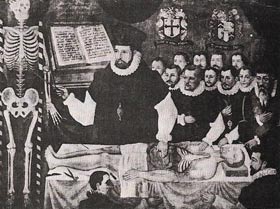anatomy

Illustration from Vesalius' great work De Corporis Humani Fabrica.
Anatomy is the structure and form of biological organisms and its study (morphology). The subject has three main divisions: gross anatomy, dealing with components visible to the naked eye; microscopic anatomy, dealing with microstructures seen only with the aid of an optical microscope; and submicroscopic anatomy, dealing with still smaller, ultrastructures. Microscopic and submicroscopic anatomy involve two closely related sciences: histology, the study of tissue that makes up a body organ, and cytology, the study of cells that make up a tissue. Anatomy can also be classified according to the type of organism under consideration: human, vertebrate, invertebrate, and plant anatomy. Since structure is closely related to function, anatomy is related to physiology.
History of anatomy
The study of human anatomy is as old as that of medicine, though for many centuries physicians' knowledge of anatomy left much to be desired. Anaxagoras had studied the anatomy of animals and anatomical observations can be found in the Hippocratic writings (see Hippocrates), but it was Aristotle who was the true father of comparative anatomy, and human dissection (the basis of all systematic human anatomy) was rarely practiced before the era of the Alexandrian School and the work of Herophilus and Erasistratus. The last great experimental anatomist was Galen. His theories, as transmitted through the writings of the Arab scholars Rhazes and Avicenna, held sway throughout the medieval period. Further progress had to await the revival of the practice of human dissection by Servetus and Vesalius in the 16th century. The latter founded the famous Paduan school of anatomy which also included Fallopius and Fabricius, whose pupil William Harvey reunited the studies of anatomy and physiology in postulating the circulation of the blood in de Mortu Cordis (1628). This theory was confirmed some years later when Malpighi discovered the capillaries linking the arteries with the veins. Since the 7th century many important anatomical schools have been founded and the study of anatomy has become an essential part of medical training. Important developments in the late 18th century included the foundation of histology by Bichat and that of modern comparative anatomy by Cuvier.
 |
| Anatomy classes based on thorough human dissection, like this one at the Barber Surgeon's Hall, London, 1581, were the foundation of a proper understanding of how the healthy body worked, and consequently how diseases were caused. Previously such scientific knowledge was hampered by a strong taboo against human dissection and an over-reliance on such classical writers as Galen. The Belgian Andreas Vesalius was the first to break this tradition.
|
The rise of microscopic anatomy has of course depended on the development of the microscope; it found its greatest success in the announcement of Schwann's cell theory in 1839.


